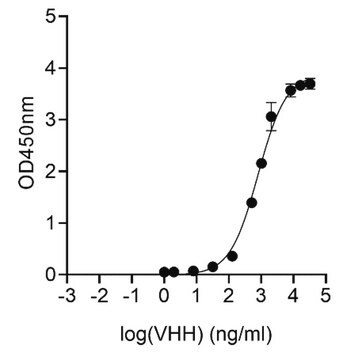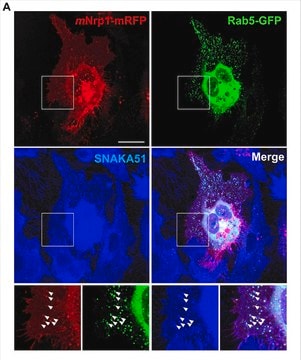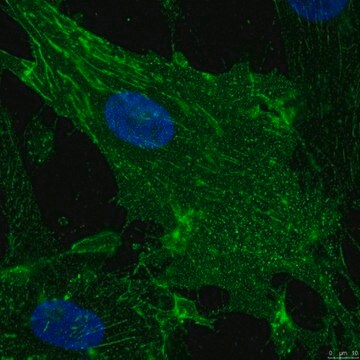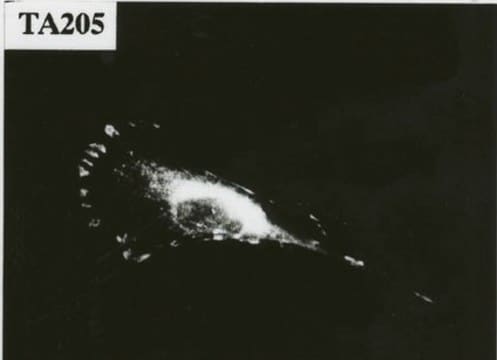一般說明
We are committed to bringing you greener alternative products, which adhere to one or more of The 12 Principles of Green Chemistry. This antibody is Preservative-free, produced without the harm or sacrifice of animals and exceptionally stable to allow for ambient shipping and storage if needed and thus aligns with "Waste Prevention", "Designing Safer Chemicals" and "Design for Energy Efficiency".
Click here for more information.
ZooMAb® antibodies represent an entirely new generation of recombinant monoclonal antibodies. Each ZooMAb® antibody is manufactured using our proprietary recombinant expression system, purified to homogeneity, and precisely dispensed to produce robust and highly reproducible lot-to-lot consistency. Only top-performing clones are released for use by researchers. Each antibody is validated for high specificity and affinity across multiple applications, including its most commonly used application. ZooMAb® antibodies are reliably available and ready to ship when you need them.
特異性
Clone 1B11 is a ZooMAb® rabbit recombinant monoclonal antibody that specifically detects 3-oxoacid CoA-transferase 1(OXCT1). It target an epitope within 16 amino acids from the internal region.
免疫原
KLH-conjugated linear peptide corresponding to 16 amino acids from the internal region of human 3-oxoacid CoA-transferase 1(OXCT1).
應用
Quality Control Testing
Evaluated by Western Blotting in HeLa cell lysate.
Western Blotting Analysis: A 1:1,000 dilution of this antibody detected OXCT1 in HeLa cell lysate.
Tested Applications
Western Blotting Analysis: A 1:1,000 dilution from a representative lot detected OXCT1 in lysates from A431 cells, Human heart and Rat heart tissue, and NIH3T3 cells.
Immunohistochemistry (Paraffin) Analysis: A 1:1,000 dilution from a representative lot detected OXCT1 in Human heart tissue sections.
Affinity Binding Assay: A representative lot of this antibody bound OXCT1 peptide with a KD of 5.7 x 10-6 in an affinity binding assay.
Immunocytochemistry Analysis: A 1:100 dilution from a representative lot detected OXCT1 in HeLa cells.
Note: Actual optimal working dilutions must be determined by end user as specimens, and experimental conditions may vary with the end user.
標靶描述
Succinyl-CoA:3-ketoacid coenzyme A transferase 1, mitochondrial (UniProt: P55809; also known as EC:2.8.3.5, SCOT, 3-oxoacid CoA-transferase 1, Somatic-type succinyl-CoA:3-oxoacid CoA-transferase, SCOT-s, Succinyl-CoA:3-oxoacid CoA transferase) is encoded by the OXCT1 (also known as OXCT, SCOT) gene (Gene ID: 5019) in human. OXCT1 is a homodimeric, mitochondrial enzyme of the 3-oxoacid CoA-transferase family. It catalyzes the transfer of the CoA moiety from succinyl-CoA to acetoacetate, producing acetoacetyl-CoA. Acetoacetyl-CoA is further metabolized by acetoacetyl-CoA thiolase into two acetyl-CoA molecules, which enter the citric acid cycle for energy production. The catalysis by OXCT1 proceeds via a classical ping-pong mechanism where each monomer binds one molecule of the first substrate succinyl-CoA, at the interface between the two domains where it is attacked by the strictly conserved Glu344 to form an enzyme-CoA thioester intermediate. This intermediate is then attacked by the second incoming substrate acetoacetate to yield the final product acetoacetyl-CoA. Mutations in OXCT1 gene are known to cause succinyl-CoA:3-oxoacid CoA transferase deficiency (SCOTD), a rare autosomal disorder that leads to episodic ketoacidosis. OXCT1 is abundantly expressed in extrahepatic tissues, including heart, brain, kidney, skeletal muscle, and lung. Two isoforms of OXCT1 have been described that are produced by alternative splicing. This ZooMAb® recombinant monoclonal antibody, generated by our propriety technology, offers significantly enhanced specificity, affinity, reproducibility, and stability over conventional monoclonals. (Ref.: Grünert, SC., et al. (2021). Biochimie. 183; 55-62; Zheng, DJ., et al. (2018). J. Pediatr. Intensive Care. 7(1); 62-66).
外觀
Purified recombinant rabbit monoclonal antibody IgG, lyophilized in PBS with 5% Trehalose, normal appearance a coarse or translucent resin. The PBS/trehalose components in the ZooMAb formulation can have the appearance of a semi-solid (bead like gel) after lyophilization. This is a normal phenomenon. Please follow the recommended reconstitution procedure in the data sheet to dissolve the semi-solid, bead-like, gel-appearing material. The resulting antibody solution is completely stable and functional as proven by full functional testing. Contains no biocide or preservatives, such as azide, or any animal by-products. Larger pack sizes provided as multiples of 25 µL.
重構
300 µg/mL after reconstitution at 25 µL per vial. Please refer to guidance on suggested starting dilutions and/or titers per application and sample type.
儲存和穩定性
Recommend storage of lyophilized product at 2-8°C; Before reconstitution, micro-centrifuge vials briefly to spin down material to bottom of the vial; Reconstitute each vial by adding 25 µL of filtered lab grade water or PBS; Reconstituted antibodies can be stored at 2-8°C, or -20°C for long term storage. Avoid repeated freeze-thaws.
其他說明
Concentration: Please refer to the Certificate of Analysis for the lot-specific concentration.
法律資訊
ZooMAb is a registered trademark of Merck KGaA, Darmstadt, Germany
免責聲明
Unless otherwise stated in our catalog or other company documentation accompanying the product(s), our products are intended for research use only and are not to be used for any other purpose, which includes but is not limited to, unauthorized commercial uses, in vitro diagnostic uses, ex vivo or in vivo therapeutic uses or any type of consumption or application to humans or animals.








